
USS Underhill (DE-682) was a Buckley-class destroyer escort of the United States Navy during World War II. Built in 1943, she served in the Atlantic, the Mediterranean, and the Pacific until her sinking in a suicide attack by a Japanese Kaiten manned torpedo on 24 July 1945.
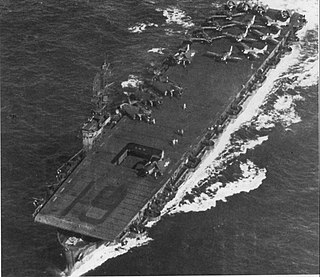
USS Manila Bay (CVE-61) was a Casablanca-class escort carrier of the United States Navy.
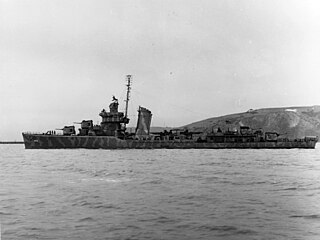
USS Hughes (DD-410) was a World War II-era Sims-class destroyer in the service of the United States Navy.

USS Peto (SS-265), a Gato-class submarine, was a ship of the United States Navy named for the peto, a sharp-nosed tropical fish of the mackerel family.

USS Foote (DD-511), a Fletcher-class destroyer, was the third ship of the United States Navy to be named for Rear Admiral Andrew Hull Foote (1806–1863), who served during the Civil War.
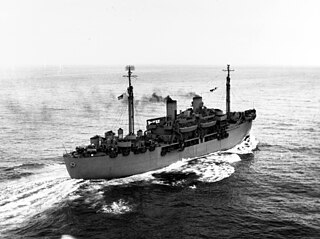
USS Gilliam (APA-57), named for Gilliam County in Oregon, was the lead ship in her class of attack transports serving in the United States Navy during World War II.

USS Bagley (DD-386), a Bagley-class destroyer, was the third ship of the United States Navy to be named for Ensign Worth Bagley, officer during the Spanish–American War, distinguished as the only U.S. naval officer killed in action during that war.

USS Patterson (DD-392), a Bagley-class destroyer, was the second ship of the United States Navy to be named for Daniel Todd Patterson, an officer of the US Navy who served in the Quasi-War with France, First Barbary War, and the War of 1812.

USS Smith (DD-378) was a Mahan-class destroyer in the United States Navy before and during World War II. She was named for Lieutenant Joseph B. Smith, USN. Smith was a senior officer aboard USS Congress and killed when CSS Virginia sank her.

USS Woodworth (DD-460) was a Benson-class destroyer in the United States Navy during World War II. She was named for Commander Selim E. Woodworth.

USS Gansevoort (DD-608) was a Benson-class destroyer in the United States Navy during World War II. She was named for Commodore Guert Gansevoort.

USS Porcupine (IX-126), an Armadillo-class tanker designated an unclassified miscellaneous vessel, was the second ship of the United States Navy to be named for the porcupine.

USS Half Moon (AVP-26) was a seaplane tender that in commission in the United States Navy from 1943 to 1946 that saw service in the latter half of World War II. After the war, she was in commission in the United States Coast Guard as the cutter USCGC Half Moon (WAVP-378), later WHEC-378, from 1948 to 1969, seeing service in the Vietnam War during her Coast Guard career.
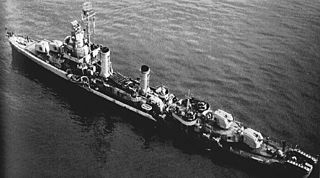
The action off Cape Bougaroun, or the Attack on Convoy KMF-25A was a Luftwaffe action against an Allied naval convoy off the coast of Algeria during World War II. The convoy of American, British, Greek and Dutch ships was attacked on 6 November 1943 by 25 German land-based aircraft. Six Allied vessels were sunk or damaged and six German aircraft were destroyed. German forces achieved a tactical victory, though the Allied warships involved received credit for defending their convoy and reacting to their losses quickly. The quick response led to the rescue of over 6,000 servicemen and civilians without further loss of life.
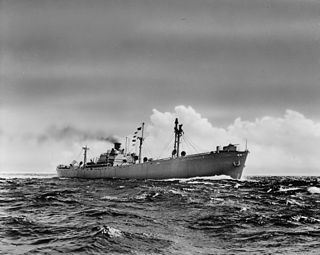
SS Marcus Daly was a liberty ship built by the Kaiser Shipyards at their Permanente No.1 yard at Richmond, California, and launched on 24 July 1943.

SS William S. Ladd was an American Liberty ship built during World War II, one of the 2,710 type 'EC2-S-C1' ships that carried all kinds and types of dry cargo during the war. She was named for William S. Ladd, an American politician and businessman in Oregon, who twice served as Portland's mayor in the 1850s. The ship's keel was laid on August 29, 1943, and 15 days later, on September 13, the hull was launched. William S. Ladd was fitted out in seven days, and was delivered to the U.S. Navy on September 20. The Navy placed Ladd under charter to Weyerhaeuser Steamship Co.
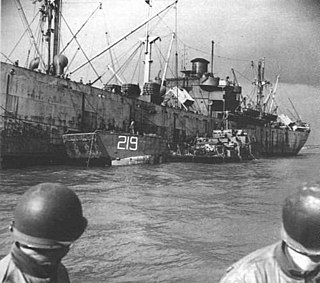
SS Alexander Majors was a Liberty ship built for the United States Maritime Commission during World War II. The ship was named in honor of Alexander Majors an American who with William Hepburn Russell and William B. Waddell founded the Pony Express. The ship was assigned by the War Shipping Administration to Isthmian Steamship Company of New York who operated it throughout World War 2. Alexander Majors was Laid down on 27 December 1943, launched on 20 January 1944 and completed on 4 March 1944, with the hull No. 2262 as part of the Emergency Shipbuilding Program.

SS Benjamin Ide Wheeler was a Liberty ship, a cargo ship during World War II. Built by California Shipbuilding Corporation (Calship) of Los Angeles for the United States Maritime Commission (USMC). Benjamin Ide Wheeler was Calship's 100th ship built. She was sponsored and christened by Mrs. Robert Gordon Sproul, wife of Robert Gordon Sproul President of the University of California system. She was named after Benjamin Ide Wheeler President of the University of California from 1899 to 1919. Her Hull # was 675, she was type EC2-S-C1 ship, built in 50 days as part of the Emergency Shipbuilding Program. Her keel was laid down on 28 October 1942, launched on 27 November 1942 and delivered on 17 December 1942. She was assigned to American-Hawaiian Steamship Company of San Francisco for merchant operation by the War Shipping Administration (WSA).

SS Hobart Baker was a Liberty ship built for the United States Maritime Commission during World War II. The ship was named in honor of Hobart Baker. Hobart "Hobey" Baker (1892–1918) was an American amateur athlete and is considered the first American star in ice hockey. He was also an American football player. The ship was assigned by the War Shipping Administration to General Steamship Company of San Francisco who operated it throughout World War II. Hobart Baker was laid down on 16 April 1943, launched on 12 May 1943 and completed on 24 May 1943, with the hull No. 1114 as part of the Emergency Shipbuilding Program, built is 38 days.

















